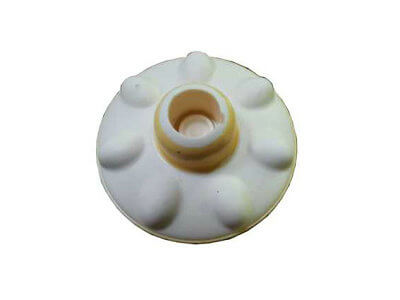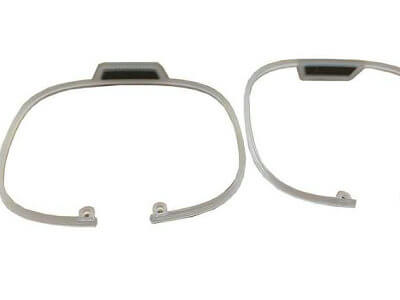In the plastics industry, injection molding is a significant process that is used to produce a large volume of plastic parts or products. This technique involves the use of a mold, usually of steel-made metal, that has an interior pattern that resembles the intended design of the part or product. The material, usually inserted after melting into a liquified or molten hot plastic state, is forced into a die cavity, eventually cooled, and then released to create thousands of similar pieces by applying high pressure.
Due to high production accuracy, almost all large-scale plastic products on the market today are fabricated through injection molding techniques. The process has many benefits, such as low cost per part production, short time per part manufacturing, accommodating several materials, and high accuracy of the final part meeting exact tolerance requirements.
These include overmolding vs. insert molding techniques. Although both are interchangeably used, there are clear distinctions between them. This blog post specifically provides key details about two techniques: overmold vs. insert mold processes, by highlighting their differences, applications, and situations to choose between the two.

Insert Molding: How Does It Work?
Both overmolding and insert molding techniques involve injection molding. In the process, metal parts are placed into a mold cavity, and then plastic is injected. These metal inserts are placed in the mold by hand or with the help of industrial robots used in automated processes. Once the mold is in position, the mold is closed, and a plastic material is injected over the metal inserts to create a single, unbroken part.
These features enable easy assembling and disassembling of the parts without any effect on the quality or appearance. For instance, heat-set threaded inserts are used in the plastic parts to reduce the likelihood of thread damage during assembly.
In addition, insert molding may sometimes even reduce the need for secondary fasteners. This technique involves the direct incorporation of required metal components into the mold to form a strong, single component that increases the mechanical stability of the part and minimizes the chances of part breakage. If you want to know more about insert molding, please go to what is insert molding page.
Why should one opt for Insert Molding?
Insert molding is an adaptive manufacturing process to produce high-strength plastic components. Let’s discuss its extensive use cases:
Reduced Assembly Costs: An injection molding machine is capable of producing thousands of parts in a minimal time frame, and this makes it economical for large batch parts production. In contrast to CNC machining, sheet metal fabrication, or 3D additive manufacturing techniques, where the assembly can become a significant problem, insert molding can minimize or even remove the need for additional assembly and tooling requirements, which will lead to further cost optimization of projects.
Enhanced Part Performance: Plastic parts are typically not as durable as their metal counterparts, but plastic has its benefits, including being cheaper, easier to mold into different shapes, and lighter in weight. Insert-molded products normally entail durability due to the combination of plastic (a substrate on which metal is inserted) and metals (insert both materials). This ensures that the intended part being inserted has the necessary strength and stiffness. Moreover, the plastic matrix helps reduce the overall weight of parts. Furthermore, insert molding imparts in parts the ability to resist cyclical loads and other loads.
Disadvantages of Insert Molding
Despite its several benefits, insert molding also comes with certain limits that product manufacturers must consider: These common drawbacks include;

Multiple Manufacturing Technologies: Insert molding may need to be done in two phases in general. Metal-forming processes such as CNC machining may be used when manufacturing custom-designed inserts rather than off-the-shelf parts. These methods are generally costlier per part than fully injection-molded processes. While it is possible to reduce the cost of manufacturing metal inserts by employing techniques such as metal die casting or metal injection molding (MIM), Despite this, the cost of manufacturing parts with metal inserts is still higher than that of parts made entirely out of plastic.
Increased Part Complexity: When producing products that have to have metal inserts made to order, it’s essential to have a deep understanding of both metal and plastic manufacturing. Product designers must know the DFM rules of both technologies and how to combine them into one part that functions as required. This can add to the design and manufacturing time and cost of the product.
An Overview of the Overmolding Process?
Overmolding is a subcategory of insert molding, which is the process of molding one plastic material directly onto a formed part. In this process, the first part is molded by injection molding, and then it is placed in the second mold for the overmolded material. This technique enables the use of two or more plastics in the production of a single product, giving the product both utility and beauty.
For example, overmolding allows for the combination of different Shore hardnesses, providing a soft touch layer on top of a rigid base for better grip and feel. Also, the use of multiple colors in an overmolded part can give it a competitive edge since it is not easily seen in other products. This technique is widely applied to the grips of tools like screwdrivers, power drills, and toothbrushes since both the comfort of the grip and the product’s appearance are essential factors.
Why choose the overmolding process?
Overmolding offers a range of benefits that make it a versatile and advantageous process.
Increased Material Flexibility: Overmolding enables the use of different materials in a single part, and this makes it possible to have different properties in the same part. This process improves the product’s looks, feel, and usability, which is advantageous to both the product and the consumer.
Elimination of Adhesives: Overmolding is a process where two or more different materials are joined together through an injection mold, thus replacing the need for adhesives or other joining techniques. This not only strengthens the final part but also cuts the assembly costs.
Integrated Seals: Overmolding makes it possible to bond soft seals directly onto molded parts. For instance, in electronics enclosures with IP ratings, an overmolded seal is cheaper and more efficient than fitting an o-ring groove. This integration enhances the performance of the part and the structural stability of the whole system.
Limitations of overmolding
Overmolding, despite its numerous benefits, comes with certain drawbacks:
Complex Process: Overmolding is a two-shot process, which means that the part cycle time and the cost are higher than in single-part molding. Also, it calls for the application of two tools or a two-shot mold that is quite expensive to produce. However, these are some of the challenges that one can face when using overmolding, but it can be cheaper than manufacturing two different injection-molded parts and then joining them.
Debonding Risk: The problem of delamination or distortion may occur when two different materials are bonded in an injection mold because the temperatures may not be ideal for the given material combination. This may require the use of mechanical interlocks in order to achieve a secure connection where heat alone is not enough.
If you want to know more about overmolding, please go to the overmolding page to check this out.
Industrial Uses of Overmolding vs Insert Molding
Both overmolding and insert molding are widely used for applications requiring high-quality and stringent products. Nevertheless, all these techniques have similar uses, and they are employed to manufacture numerous parts and products.
Automotive Industry
Both insert molding and overmolding play a vital role in manufacturing numerous automotive parts that contain metal, rubber, or plastic, such as batteries, knobs, dash panels, motors, and handles.
Cosmetic Industry
These techniques are indispensable in the cosmetics industry for producing custom-made items and their containers with the use of various colors and surface treatments of cosmetic items such as perfume flacons, cosmetic brushes, and compacts.
Consumer Products
In the case of household products, insert mold and overmold play a central role in manufacturing items such as toothbrush holders, containers, and cell phone cases. They also reinforce items such as patio chairs and step stools, which are usually found in multiple colors or materials.
Electrical Appliances:
The use of insert molding cannot be overemphasized, particularly in the electrical industry, where wires are coated with rubber insulation. This process helps to stop electrical conduction and increase safety levels. Insert molding also makes electrical appliances safer to handle by providing a proper place for insulators to be installed.
Sincere Tech is one of the top 10 plastic injection molding companies in China that specializes in creating unique products for different sector., With the help of the technical knowledge and skills that the company has gained over the years, the company offers its services at affordable prices. Whether for consumer products, home appliances, or car accessories, you can rely on these processes for quality production.

Conclusion: Selecting Between Overmolding, Insert Molding, and Injection Molding
Overmolding and insert molding are the different techniques that fall under the injection molding process, which is a popular and efficient method of manufacturing consumer goods. As for the cost, injection molding is generally considered to be the most cost-effective method compared to other methods such as CNC machining and 3D printing per part.
Overmolding could be an optimal choice if:
- Your part’s surface has different electrical or thermal properties.
- It is essential to increase the level of shock absorption or decrease the level of vibrations.
- It is necessary to produce a part from multi-colored plastic.
- Your part must offer a comfortable, non-stick surface that the other part can easily grip.
Opt for insert molding when:
- The substrate can be in the form of wires, electronic components, or circuit boards.
- It is preferred not to have to spend the money on a two-shot mold or a 2K, which is more complicated.
- You have to tap this part and install threaded inserts.
When the decision has been made to use injection molding for a certain application, the next choice is between insert molding, overmolding, or conventional injection molding. It is important to provide a clear definition of the product application to be able to make a proper choice. All these processes have their own special benefits suitable for various products. Deciding which method is right for your particular product is not always easy; therefore, it is advisable to consult a professional.
Speaking to a SincereTech representative can be helpful due to over a decade of the company’s experience in manufacturing. We can assist you in the decision-making process of your project and determine which process—insert molding, overmolding, or standard injection molding—will be most beneficial for your project.
FAQ’s
Q1. What is the process of TPE overmolding?
TPE overmolding is a process where TPE is injected into an existing substrate or a plastic part to form a chemical bond with the material in order to increase its durability and usefulness.
Q2. Is 2K injection molding the same as insert molding?
No, Insert molding involves placing an additional part on the substrate, while 2K injection molding involves injecting multiple materials into multiple-cavity molds for the production of intricate parts for vehicles.
Q3. What plastic types are suitable for overmolded?
The most commonly engineered plastics suitable for overmolding processes include high-density polyethylene (HDPE), PEEK resin, Delrin or acetal, polymethyl methacrylate acrylic, commonly known as PMMA, ABS, nylon, and PBTR. These plastics have different characteristics that make them suitable for different overmolding processes across industries like automotive and consumer products.
Q4. Overmolding vs. Insert Molding: Which One Costs More?
Overmolding, however, provides economical scalability at higher production rates for companies, which in turn increases the overall profitability of a company through decreased tooling and assembly costs. Further, it helps with faster production of parts in large-volume runs. If you are going to produce intricate prototypes or low-volume parts, this cost differential becomes apparent due to the requirements of two parts.













